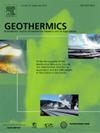Method for imitating scale formation in the Takigami binary power plant in Oita, Japan: Establishment of primary synthesis conditions
IF 3.9
2区 工程技术
Q3 ENERGY & FUELS
引用次数: 0
Abstract
The advantage of suitable anti-scaling technologies for individual geothermal plants would benefit from shorter development periods, making it necessary to improve the precision in evaluating a scaling technology through laboratory testing. This study focuses on developing a technology to replicate the scale formed in the Takigami binary geothermal plant. The artificial scale obtained was compared with an actual scale collected during jet washing that followed the chemical washing process in the evaporator of the Takigami binary power plant. The artificial scale was synthesized in controlled environments by removing dissolved oxygen and introducing carbon dioxide (CO2) to simulate geothermal conditions. The artificial scale resembled the natural scale, predominantly comprising silica and metal silicates. Although the scale formed in the Takigami binary geothermal plant differed from the artificial scale in terms of particle size, the size of the dispersion particles in the geothermal brine was similar to that of the dispersion particles in the synthesized solution. In addition, the amounts of enriched elements differed from those in the natural scale, with higher aluminum and lower calcium concentrations. These discrepancies highlight the need for additional adjustments in synthesis conditions to more precisely replicate the natural scaling environment. We illustrate how laboratory-scale synthesis can help successfully imitate the intricate natural scaling processes, providing valuable insights for enhancing scaling management in geothermal facilities. Optimizing the gas and chemical inputs may help further improve the precision of these simulations. The interactions between the material and solution particles need careful consideration.
模拟日本大分县泷上二电厂结垢的方法:初步合成条件的建立
适合于个别地热发电厂的防结垢技术的优势将得益于较短的开发周期,因此有必要通过实验室测试提高评价结垢技术的精度。本研究的重点是开发一种技术来复制Takigami二元地热发电厂形成的规模。将所得的人工水垢与Takigami电厂蒸发器化学洗涤后射流洗涤过程中收集的实际水垢进行了比较。通过去除溶解氧和引入二氧化碳(CO2)来模拟地热条件,在受控环境下合成人工水垢。人工水垢与天然水垢相似,主要由二氧化硅和金属硅酸盐组成。虽然Takigami二元地热发电厂形成的水垢在粒径上与人工水垢不同,但地热卤水中分散颗粒的粒径与合成溶液中分散颗粒的粒径相似。此外,富集元素的数量与自然尺度不同,铝浓度较高,钙浓度较低。这些差异强调需要在合成条件下进行额外的调整,以更精确地复制自然缩放环境。我们说明了实验室规模的合成如何帮助成功模仿复杂的自然结垢过程,为加强地热设施的结垢管理提供了有价值的见解。优化气体和化学物质的输入可能有助于进一步提高这些模拟的精度。材料和溶液粒子之间的相互作用需要仔细考虑。
本文章由计算机程序翻译,如有差异,请以英文原文为准。
求助全文
约1分钟内获得全文
求助全文
来源期刊

Geothermics
工程技术-地球科学综合
CiteScore
7.70
自引率
15.40%
发文量
237
审稿时长
4.5 months
期刊介绍:
Geothermics is an international journal devoted to the research and development of geothermal energy. The International Board of Editors of Geothermics, which comprises specialists in the various aspects of geothermal resources, exploration and development, guarantees the balanced, comprehensive view of scientific and technological developments in this promising energy field.
It promulgates the state of the art and science of geothermal energy, its exploration and exploitation through a regular exchange of information from all parts of the world. The journal publishes articles dealing with the theory, exploration techniques and all aspects of the utilization of geothermal resources. Geothermics serves as the scientific house, or exchange medium, through which the growing community of geothermal specialists can provide and receive information.
 求助内容:
求助内容: 应助结果提醒方式:
应助结果提醒方式:


